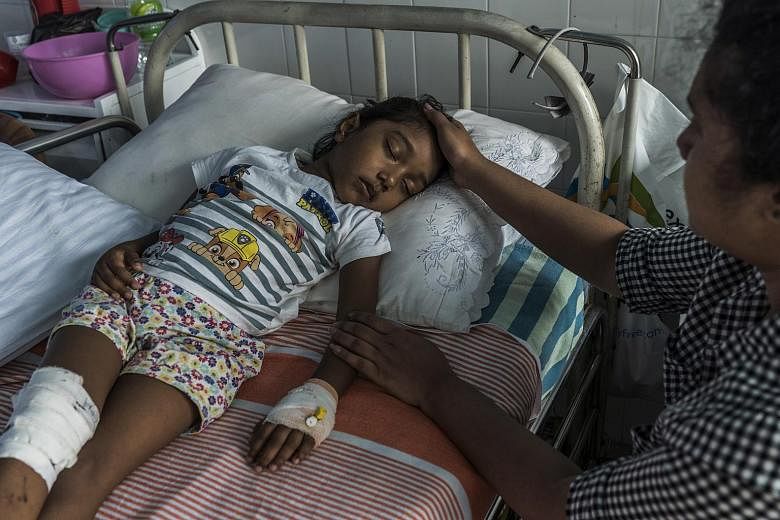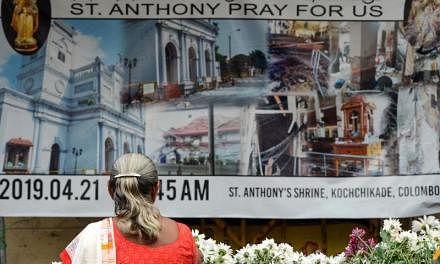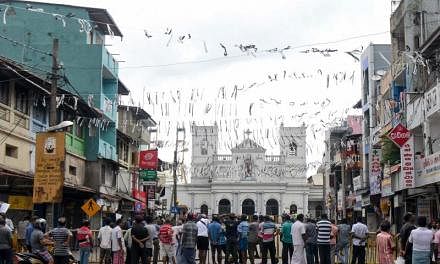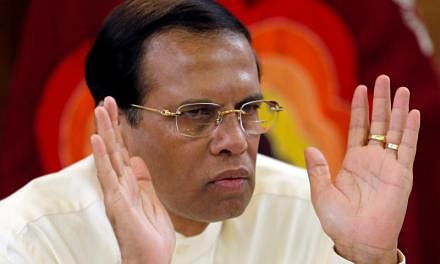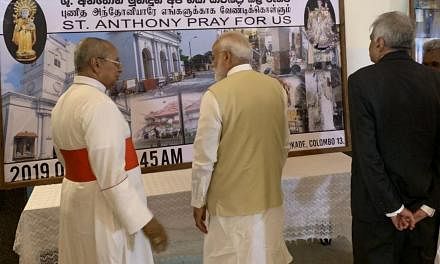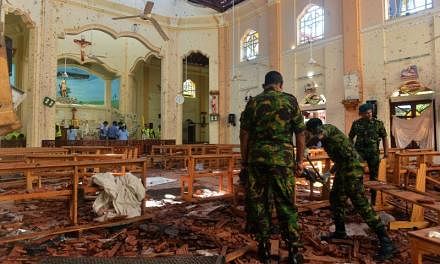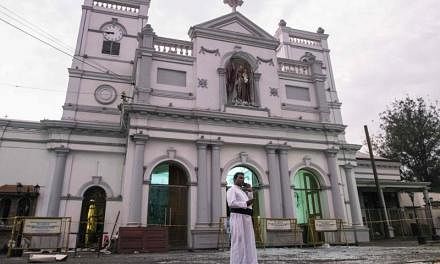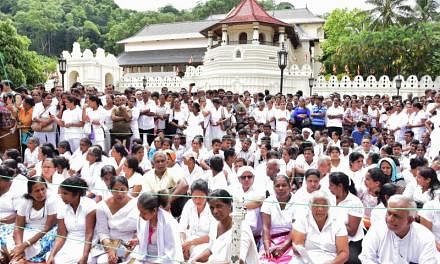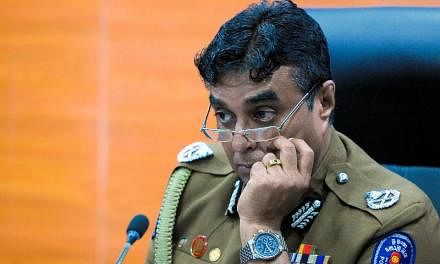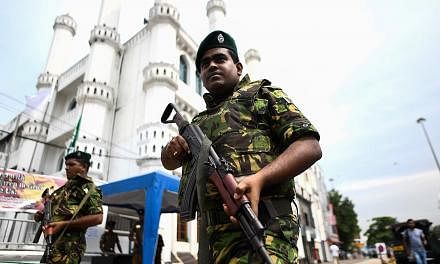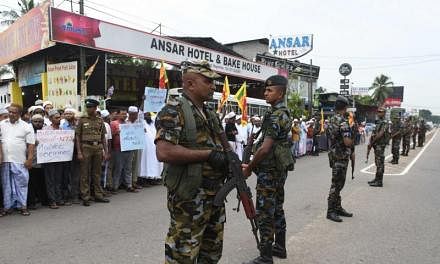COLOMBO (NYTIMES) - In a room in front of the nurse's station at Lady Ridgeway Hospital for Children, in the Sri Lankan capital of Colombo, a 5-year-old girl rolls around her bed at night, shaking and crying silently.
Doctors are worried about the girl, S. Diduni Nihansa. Dark pools have collected under her eyes. She will not talk. When a suicide bomber blew himself up during Easter Mass at St Sebastian's Church, killing around 100 people, she was blasted off a pew with such force that her lungs bled.
Diduni's 8-month-old brother, S. Dinuja Matthew, was sitting a few rows away, on his grandmother's lap, his mother, Disna Shyamali, recalled. As the air filled with panicked, full-throated screams, somebody picked up his lifeless body and yelled: "Whose baby is this?"
A little over a week after the terror attacks, Sri Lanka's roads are no longer empty. Nighttime curfews have been lifted, and many social media platforms have been unblocked at certain times of the day. Life, for many, is beginning to get back to normal.
But not for Sri Lanka's youngest generation. Of the more than 250 people who died in suicide attacks Easter morning, officials believe that as many as 50 were children.
Dozens more were badly wounded. A 7-year-old in the hospital lost an eye; a 4-year-old was in a coma. Many, sprayed with lethal fragments, suffered internal injuries, some were covered in burns.
The deepest scars may not be physical.
Countless young people bore witness to some of the most horrific scenes imaginable: broken, dismembered bodies; floors slicked with blood; parents virtually paralysed with grief, clutching siblings' coffins as they disappear into the earth.
For more than 25 years, ethnic tensions between the majority Sinhalese and the minority Tamils nearly tore this lush green island into two. But the war with the separatist Tamil Tigers ended in 2009, and the hope was that this generation would be Sri Lanka's first in decades to be spared such violence.
Before Sunday (April 21), children under the age of 10 had never heard of a curfew, never felt the ground shudder as a bomb explodes or known what it is like to see death not as a mystery but as a fact of life.
For now, at least, Sri Lanka is back on a war footing. Soldiers are patrolling the streets. People start at loud noises. The government is putting in place old war rules, ended years ago, like requiring schoolchildren to carry their books in transparent bags to make sure they are not toting bombs.
On Monday (April 29), the country's president, citing the limited state of emergency he imposed last week, banned "all forms of clothing that cover a person's face and prevents them from being identified", an order seen as being directed at the niqabs and burqas that some Muslim women wear in public.
Difficult questions keep coming up. Mr Asanga Abeyagoonasekera's two young sons ask him, repeatedly: "Why do people bomb?"
He and his family narrowly escaped the double suicide bombing at the Shangri-La Hotel, which killed 33 people, including three of the four children of a billionaire Danish clothing tycoon.
Rushing down a fire escape, the Abeyagoonasekeras were forced to traverse bloody ground littered with body parts. Mr Abeyagoonasekera and his wife tried to cover the boys' eyes, but they saw the carnage.
Mr Abeyagoonasekera, a foreign policy expert for Sri Lanka's Defence Ministry and was 16 years old when his father was killed during the war, tried to answer his sons' questions as best he could.
"There are bad people, and sometimes they bomb," he said, telling them not to worry because a superhero was coming to save everyone.
But the fear remains.
When he goes off to work now, his youngest clutches his waist and does not want to let go.
Having these conversations has also been hard for Ms Renuka Kumari.
Outside a small home surrounded by plants near St Sebastian's Church, she tried to console her 7-year-old daughter, Biguni, who slumped in a chair in sticky, afternoon heat, dripping orange juice on a neck brace.
Biguni grunted in pain. Tiny pieces of metal sliced through her body at supersonic speed. Ms Kumari tipped a capful of medicine over her daughter's lips and she swallowed roughly.
"It hurts," Biguni said.
Of the eight sites attacked on Easter, St Sebastian's Church in the city of Negombo was the hardest hit. A suicide bomber walked into the crowded church with a backpack, his shoulders hunched under the weight, which authorities believe was more than 100 pounds.
The explosion blew off much of the roof above the high vaulted ceiling. Heavy clay tiles rained down on people's heads.
The nights are hard. Biguni has trouble sleeping. Her father rocks her, but even when she does drift off, she has nightmares. When she wakes, she keeps asking if her grandmother is leaving the hospital. Ms Kumari does not know how to tell her that her grandmother is dead.
"Something has been lost," she said. "We are so broken."
Near St Sebastian's Church, many parents are furious and bitter. They want to know why their elected leaders did nothing to stop the attacks despite clear intelligence warnings from Indian officials nearly two weeks before they happened.
In a large, sparse living room, Mr Ranjeeva Silva trembled. His 12-year-old son, Eanosh Lakwin Silva - the one, he said, who could tell you about Sri Lanka's kings, who loved Lionel Messi, who sculpted objects from clay and paper - was dead.
A relative approached him. They talked about how they would not care if all Sri Lankan politicians died. They said the outrage on display in the government was just a "show".
"They're all in front of the media arguing, but at the end of Parliament, they eat together," Mr Silva said.
His son's "favourite thing", he said, his voice cracking, was "hugging and giving".
At Lady Ridgeway hospital, a child injured in the bombings dragged a leg cast on the ground. Down the hallway, relatives took shifts to keep watch on Diduni, who curled in the foetal position. Her eyes fluttered in the light.
Two months earlier, Mr S. Dinesh Suranga Sanjeewe had moved most of his family to Sri Lanka from Naples, Italy, where he had worked in a garment factory for years, raising Diduni, another daughter and the 8-month-old baby.
He and his wife, Ms Disna Shyamali, were excited to move back to Sri Lanka, he said. They wanted to enroll their children in better English-language schools, and have more space to live in. They were building a house in Negombo. He recalled Diduni hopping through the gray, unfinished shell, cracking jokes, taking bunny ear selfies and serving relatives make-believe food made of sand and leaves.
Mr Sanjeewe, who had stayed behind in Italy while the family was setting up in Sri Lanka, was frantic when neighbours in Negombo called and told him there had been a bombing. He rushed to book a flight. He got another call. The little one had died.
Sometimes his wife sleeps clutching a framed picture of her baby. She sobs when she sees his clothing. She mourns her mother, the grandmother who was holding Dinuja Matthew on her lap when the bomber pressed his switch.
They have not told Diduni about her brother, whom she tickled and spoke to in gibberish. They know there never will be a right moment.
Outside their house, they have hung a banner to commemorate his death. A blurry photo shows him dressed in a vest and tie. He smiles at somebody up above. Big, bold letters announce his name.
